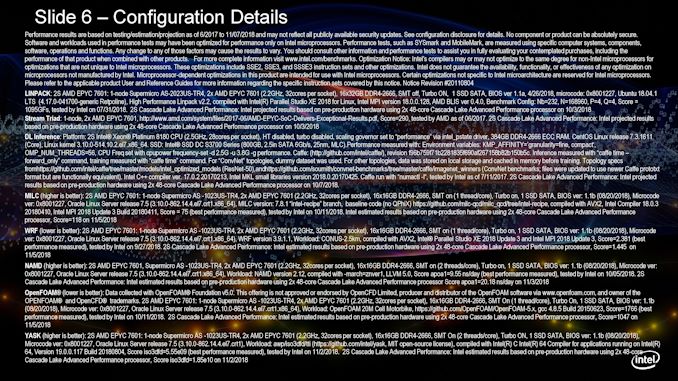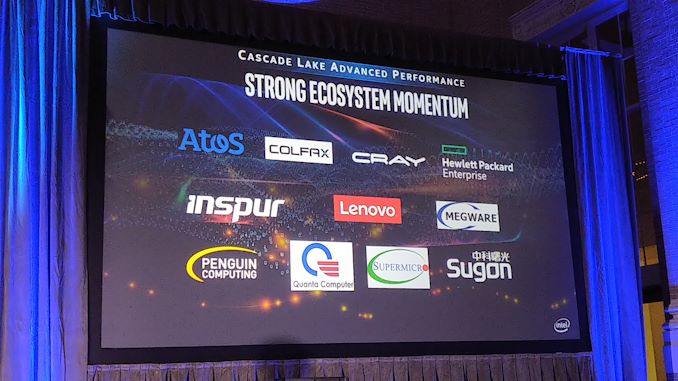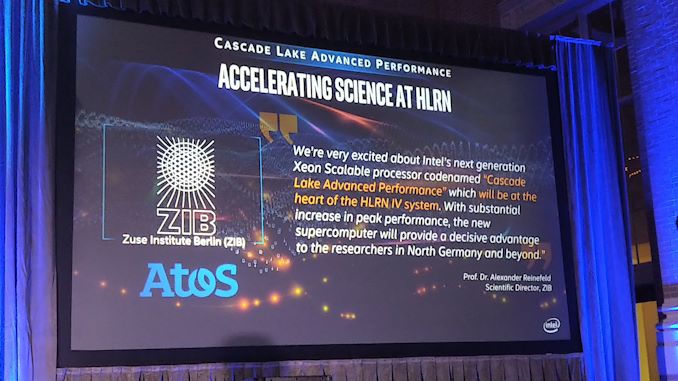Intel Offers More Cascade Lake-AP Performance Numbers
by Ian Cutress on November 11, 2018 6:15 PM EST- Posted in
- Enterprise
- Intel
- HPC
- Enterprise CPUs
- Cascade-AP

One of the announcements from last week involved Intel and its new Cascade Lake Advanced Performance category of processors to launch next year. These new processors will be based on combining two 24-core Cascade Lake-SP processors on a single package substrate to offer a single socket 48-core option with a total of twelve memory channels. The Cascade Lake-AP parts are going to be launched next year, and until then Intel is putting out some internal benchmark numbers.
Vendor Benchmark Results
When we are this far away from a product launch, all benchmark numbers should be taken with a grain of salt. This goes doubly so for vendor supplied benchmarks. However, Intel is on the warpath to promote what it sees as a new product family within its portfolio, even if it is only set to come out next year.
At the announcement last week, Intel offered Linpack and Stream Triad as two main high-performance metrics as comparison. Today Intel is also offering more ‘real world’ metrics. These metrics are, to quote Intel, ‘estimates based on pre-production hardware’. This means that the hardware is not ready yet, and these are values based on the engineering samples running but extrapolated to an expected benchmark value. Add another dump truck of salt on these numbers.
Intel’s official list of results are as follows:
| Intel's Benchmark Numbers for 2S 48 Core Cascade Lake-AP |
||
| Benchmark Type | Score vs 2S EPYC 7601 | |
| *These numbers were created by Intel | ||
| Linpack | Numerical Linear Algebra | 3.4x |
| Stream Triad | Memory Bandwidth | 1.3x |
| MILC | Quantum Chromodynamics | 1.5x |
| WRF | Weather Forcasting | 1.6x |
| OpenFOAM | Computational Fluid Dynamics | 1.6x |
| NAMD (APOA1) | Molecular Dynamics | 2.1x |
| YASK (ISO 3DFD) | HPC Kernel Tuning | 3.1x |
The slide with this data is in the gallery below.
In each case, Intel is comparing a dual-socket Cascade Lake-AP system with a dual socket EPYC 7601 system. Intel’s information slides go through how it set up all of its AMD systems in detail, however it does not disclose how the Cascade Lake-AP systems are set up by comparison, presumably as to not disclose any additional set-up numbers.
For the most part, we don’t put much stock into vendor supplied benchmark numbers. It’s easy for a vendor to claim a multiple when doubling particular compute resources, but when it comes to real world tests, companies like Intel have to try and promote its future products to potential customers. This is what this is. However, no matter how many numbers come out, these are impossible to verify independently. Wait until the AnandTech review, of course.
Intel also disclosed a number of ecosystem partners who are getting ready to deploy Cascade Lake-AP, as well as an offical declaration of the Cascade Lake-AP deployment at HLRN.
Cascade Lake-AP is set to be launched alongside the Cascade Lake-SP in the first part of 2019, although Intel states that Cascade Lake-SP will ship for revenue in 2018. This week we are at the Supercomputing trade show - hopefully there will be a demo somewhere that we’ll be able to see and talk about.



















52 Comments
View All Comments
FredWebsters - Wednesday, December 26, 2018 - link
I think that there are only cool products!IGTrading - Monday, November 12, 2018 - link
Most test results shown by Intel are well bellow the 200% to 400% performance improvement demonstrated by #AMD EPYC2 .Add to that that Intel's CPUs will use a huge load of power and will also need new infrastructure with motherboards and everything and you get a disastrous 2019 year for Intel.
Not "disastrous" because AMD will take 90% of the server market , not at all, but because that 5% "red line" imposed by Intel's former CEO on the server market will likely be pushed back towards 15% which is a truly disastrous result comparing with the initial goal of the company.
What makes it even worse for Intel is that AMD will also have the revenues & profit to keep investing and developing new tech which will put it in a completely different position than the cash-strapped scenario it has been into, during the past 10 years.
Gondalf - Monday, November 12, 2018 - link
You forget what is Rome. And half 7nm SKU, so with halved power savings over 14nm. In this condition Cascade AP on 14nm++ is well enough. Rome was a delusion under many espects.Meaker10 - Monday, November 12, 2018 - link
The I/O does not account for half the power, the cores consume the large part of it.Spunjji - Monday, November 12, 2018 - link
You picked the wrong comment to reply to given that IGTrading never mentioned power, but I'll take that bait.Realistically (as in, without reeking of bias) we can assume that AMD are targeting increased performance at roughly the same ISO power consumption for their new chips, because that's how server designs work. Even if your baseless half-and-half claim is correct (and that's a big if) AMD's accordingly modest performance gains for Rome would still make them competitive with CLAP, and with a less-expensive and more-mature platform to boot. In reality there's no reason to doubt AMD's claims of 2-4x performance boost depending on the application (twice as many cores, twice the FP width, similar power draw).
Put simply, your stupid FUD comment is stupid FUD.
RogerAndOut - Tuesday, November 13, 2018 - link
You seem to miss understand the issues with design limits. The I/O interfaces of all processors regardless of manufacturer have the same issue. Regardless of their design size (3nm,5,10,14,22...) they have to accept, switch and deliver the current and voltage required by the interface they support (DRAM, PCI, USB, SATA....). So even once Intel has its 10nm process fully operational they will not gain much advantage over AMD even if their interface logic is also 10nm in size.Opencg - Monday, November 12, 2018 - link
True. The difference is infinity fabric was a seriously thought out long term technology designed to be used in both cpus and gpus. It has its own set of disadvantages so multi die microprocessors have to be designed correctly from start to finish.Intel established a trend of doing whatever they want for 8 years and got caught with their pants down in so many ways. This is a rushed response by a company freaked out over losing market share, 10nm could still be a huge problem for them (they would never admit it until they have to). Not really the right conditions to launch a technology like this.
HStewart - Monday, November 12, 2018 - link
I think you are forgetting that by time EPYC2 is out - Intel will likely have it based on Ice Lake and will significantly improved it even based on this process. It just so how interesting when AMD talks vaporware people cheer - but Intel talks they are doing and people don't believe it.This is probably why companies do not trust AMD. Big difference between Intel and AMD is Intel is scalable - meaning that it not just 2P systems, but also 4P and 8P and even more. So core count is not really that important when you can just add more cpu's on same system.
HStewart - Monday, November 12, 2018 - link
One thing I am curious about if a system have 4 16 core cpus each with their own dedicated memory or single 64 core cpu - with memory that is shared - which is actually better especially when taking to larger systems with say 128 plus CPU and one of them fails. For me scalable sounds more reliable.Haawser - Sunday, November 11, 2018 - link
Seeing as AMD just showed a prototype EPYC2 beating two top of the line 28C Xeons, I'm not sure that two 24C ones are going to stand much of a chance.